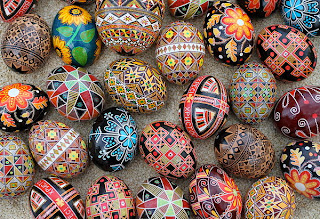As one who facilitates art for children, I find it important to continue to learn and develop my own creative skills. I have always admired Pysanky, the ornate Ukrainian Easter eggs, and wanted to try my hand at making them. When a friend invited me to a Pysanky workshop, I immediately said yes, even though I had a million things to do to prepare for our trip to the States over Easter!
Below you can see the materials needed for the project: a raw egg, a pillar candle, beeswax cake, a pencil and a "kistka". There are actually three kistkas in this picture and these are pencil-like instruments with a metal well and sharp point attached to the end. The beeswax flows through the well and and sharp tip and with it you "draw" your design on the egg with beeswax. The latte macchiato is optional.: )
 |
| Assorted Pysanky Source:Wikipedia |
Below you can see the materials needed for the project: a raw egg, a pillar candle, beeswax cake, a pencil and a "kistka". There are actually three kistkas in this picture and these are pencil-like instruments with a metal well and sharp point attached to the end. The beeswax flows through the well and and sharp tip and with it you "draw" your design on the egg with beeswax. The latte macchiato is optional.: )
You also need special dyes for the eggs. Ours were in large peanut butter jars.
My teacher, Ruth, was an American woman who learned the technique while living in Berlin. She taught us to lightly section the egg off by drawing latitude and longitude lines with a pencil. This helped me greatly in understanding how to begin making such a complex design. Design has never been one of my strong points and the Pysanky designs seem visually overwhelming at first.
It is important not to draw heavy lines, because they will show through the dye. If you make a mistake, then a little vinegar can take off some of the pencil marks. (Also, if your eggs are stamped like ours in Berlin, the vinegar will take off the stamp.)
A closer look at the sectioning:
Then, you choose designs such as flowers, stars, or triangles to put in each section. Our teacher provided some booklets with examples to get our creative juices flowing.
When all of the designs are completed, the next step is to decide what parts of the egg will remain white. These lines will then be covered in beeswax with the kistka as seen below.
I chose to do a simple pattern of flowers and waves. Here is my first attempt with the dye. We learned that you start with yellow first and then move to the darker colors.
After the yellow dye, I decided which parts would remain yellow and began covering those areas in beeswax. You continue this process with each color. Below is another student's work.
Ruth was also simultaneously creating an egg:
After two hours, my egg looked like this:
I had to leave before I had a chance to do each color, in order to make another appointment, so Ruth promised to take the egg home and do the final stages of removing the beeswax, blowing the egg with a special tool and varnishing it. Below is a picture of my finished egg. Not bad for a first try!
Here are some of Ruth's eggs:
I ordered this Pysanky kit for my children and hope to make some Pysanky with them after Easter. Stay tuned in the next couple of weeks for photos. For a proper tutorial from someone who regularly does Pysanky with children, head over to That Artist Woman!
This was such a fun experience, and as my friend commented while we were making them, I can't wait to see how we incorporate Pysanky into our work with children!
linked to The Magic Onions













They are very beautiful :-) thanks for sharing
ReplyDeleteThank you for reading along!
Delete